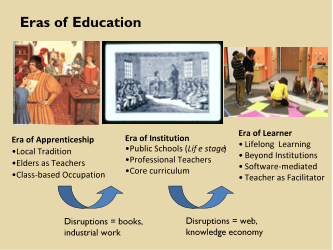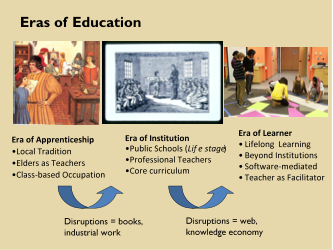
This is a very important question for museums, don’t you agree? If museums are, fundamentally, educational in nature, if this role is the basis of our tax-exempt status and our major contribution to society, it’s crucial for museums to maximize their effect on the educational landscape. Lately, we’ve been rather marginalized—by No Child Left Behind, standardized curricula and testing and cuts to educational funding that make the traditional field trip an increasingly rare beast.
There are indicators that we may be reaching the end of the current era of institutional learning, an era characterized by teachers, physical classrooms, age-cohorts, and a core curriculum. If this is so, what will the next era look like? Will it be one in which museums can play a more central role?
If you believe KnowledgeWorks’ 2020 Forecast: Creating the Future of Learning, the answer is yes, museums are pre-adapted to be major players in the next era of education. The recently released update to this forecast envisions a future premised on individualized, self-directed education in which learners “collaborate with educators and with experts in their communities and around the world to customize rigorous learning experiences based on competency and interest instead of time and age.”
The report outlines six drivers of change that will shape the coming era:
- Biotechnology that will enhance our cognitive abilities.
- Open, collaborative design platforms that facilitate distributed learning systems.
- Coordinated infrastructure linking resources and services within communities.
- Bottom-up activism of “educitizens” using social media to tackle issues and drive civic change.
- The increasing desire for informal learning and hands-on “maker” experiences.
- The ability to collect, aggregate and stream data to measure learning experiences, track resources and test potential educational strategies.
For each driver of change, the report suggests stories and resources for further reading (“signals of change”), and steps individuals and organizations can take now to prepare for the coming era. Many of these actions are things that museums are, or want to be working on now, for example:
- Partnering with organizations and groups in their communities to explore new ways of approaching learning.
- Exploring new funding mechanisms or business models to support their roles as learning agents.
- Using technology to help students, teachers and the community access their learning resources.
- Experimenting with assessment of informal learning (an area in which museums can share expertise with the formal educational system).
One could construct rather extreme scenarios of the future based on these drivers (neuro-enhanced teens contributing to international research via gaming while constructing their own laboratory equipment!). But then again, if you told a young journalist in 1980 that in thirty years he would be a self-employed blogger, funding his investigative research through Kickstarter, relying on hackers and citizen journalists as key sources and streaming his content to readers via multiple social media platforms, he’d have thought you were nuts…










I do believe this is an important question Elizabeth. In fact, lately I am constantly asking myself how might I encourage my college students to interact and engage the local museum community as both members of the community and students interested in design. It is the basis for the new program I am hoping to launch in Huntington, IN at Huntington University, where the students reach out to the museum community to offer their voice and thoughts in an effort to learn and get involved.
Thanks for starting the conversation and asking the big questions!
I am curious about the possibilities of museum membership as a multi-level or tuition-oriented funding model. As we think of museums offering curriculum-based content backed by quality evaluation methods and the increasing access to unique primary source research materials via both physical and virtual means (digitization projects abound!), shouldn't we also be talking about building on existing models for content access such as JSTOR et. al or the university tuition models in the conversation about how we fund this educational transition?